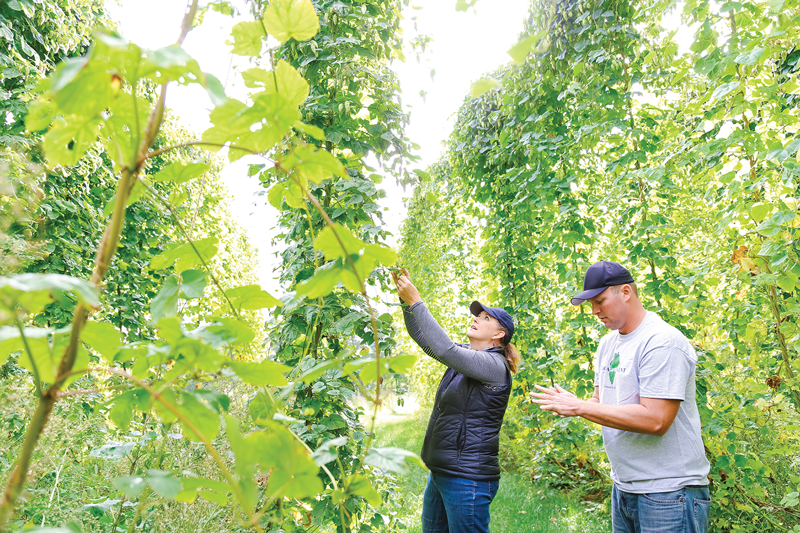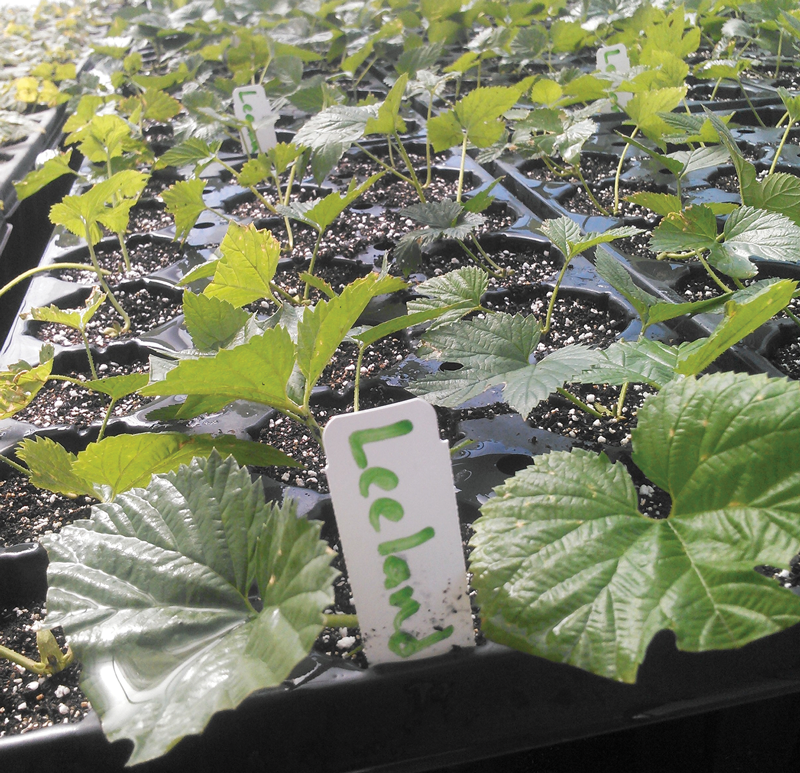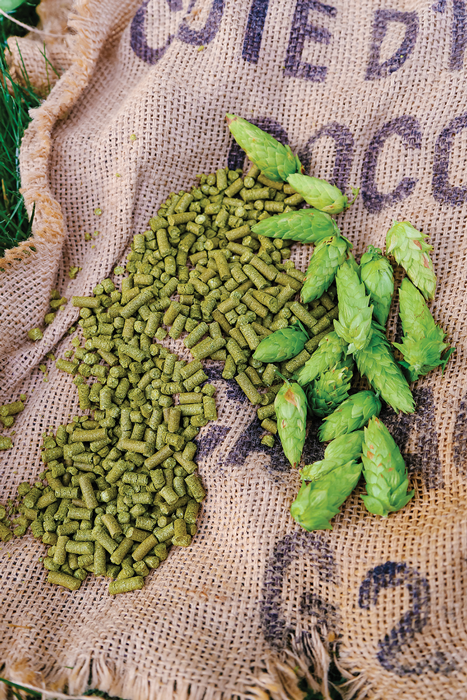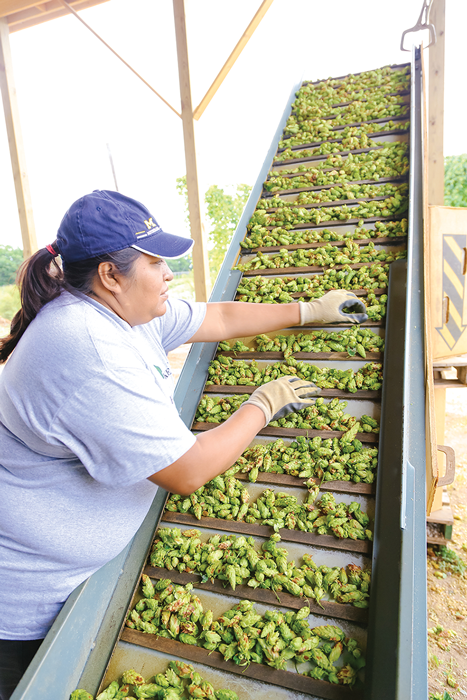By Howard Meyerson
As the summer sun warms farm fields around the state, a new crop of farmers is tending the land. Young and hip or older and settled, they are looking for a new lifestyle. What they grow is hops — an essential beer ingredient that adds bitterness and aroma. Their budding fields have become an important part of the state’s booming craft beer economy.
Michigan craft brewers made a $1 billion economic impact in 2012, according to the Brewers Association, a national trade organization in Boulder, Colo. That year, 131 enterprises dotted the nation. Many more brewers have since opened their doors.

“Hop farming is an artisan industry and it’s growing like crazy,” notes Robert Sirrine, community food systems educator for Michigan State University (MSU) Extension. “It’s also ‘cool.’ These people take pride in their product. You can farm 200 acres of corn and have it go to cattle feed, but growing hops plays on the local food thing and connecting with consumers. That’s why craft brewers are showing up everywhere.”
Michigan leads the nation in growing blueberries and tart cherries. It ranks third in the United States for apple production, according to the Michigan Department of Agriculture and Rural Development. With just 300 acres of planted hops in 2014, the state ranked fourth for hops. A report by Hop Growers of America, a national trade association, shows Washington State was tops with 28,858 acres that year, followed by Oregon (5,410 acres) and Idaho (3,743 acres). Sirrine estimates Michigan will have 800 acres by the end of 2015.
 “We surveyed Michigan brewers in 2008 and determined it would take 400 acres (of hops) to produce the volume of beer being brewed in Michigan,” Sirrine explains. “But the number of brewers has more than doubled. There were 80 then. We are pushing 200 now. The hops business is mirroring the growth of the craft beer industry. And most of what is grown here is sold locally.”
“We surveyed Michigan brewers in 2008 and determined it would take 400 acres (of hops) to produce the volume of beer being brewed in Michigan,” Sirrine explains. “But the number of brewers has more than doubled. There were 80 then. We are pushing 200 now. The hops business is mirroring the growth of the craft beer industry. And most of what is grown here is sold locally.”
Hops are de rigeuer: A growing number of cultivators are investing in land, planting popular varieties and attempting to make a go of it. Pam Miller was in the day spa industry before she retired to grow hops. Her husband, John Miller, works as an industrial machine specialist. The couple invested $600,000 in their four-year-old Greenville hops farm, Hopyards of Kent Co., where hops grow on 13 of the 40 acres they bought for retirement.
 John wanted something other than beans or corn, crops grown on his father’s Ionia hobby farm. It was during a Sunday evening family dinner that Ian Mortensen, the Miller’s son-in-law and business partner, suggested growing hops. He grew up in Washington’s Yakima Valley where family friends had an enterprise. The Millers and Mortensen traveled out-of-state to learn more and realized they were looking at an opportunity.
John wanted something other than beans or corn, crops grown on his father’s Ionia hobby farm. It was during a Sunday evening family dinner that Ian Mortensen, the Miller’s son-in-law and business partner, suggested growing hops. He grew up in Washington’s Yakima Valley where family friends had an enterprise. The Millers and Mortensen traveled out-of-state to learn more and realized they were looking at an opportunity.
“We could see what was happening in the craft brewing industry in Michigan,” John shares, “so we got in and hoped it would keep growing.”

Twenty-foot hop bines now grow on trellises in the Millers’ fields. Come fall, each will be laden with hop cones — the female flower containing crucial alpha-acids, the compound that provides the bittering needed to flavor beer. The mature bines will be cut down and fed into the hops harvester, a large machine that picks the cones, which then get air-dried, tested for moisture-content, milled, pelletized and bagged for sale.
Samples get shipped to a laboratory before harvest to assure readiness, the couple notes. A second sample will be sent after harvest to test for acid content.

“There are world-wide (alpha-acid) standards for each variety,” Pam explains (see sidebar, opposite page). “Brewers want to know the numbers in order to meet the requirements of their recipes.”
Four varieties grow on the Miller farm, one for bittering and three for aroma. Each variety of hops has a unique flavor profile, described as spicy, citrus or floral. The Millers anticipate growing more than 10,000 pounds this year, double their volume in 2014.

A productive acre of hops can yield 2,000 pounds or more, according to Sirrine. Michigan hops sell for $12 to $14 per pound. It is more expensive than western-grown options, but most brewers willingly absorb the premium, he notes. In turn, they get fresh hops, a guaranteed supply and a locally-grown product.
A Budding Industry

Michigan farmers grew hops in the mid- to late 1800s, as did farmers in Wisconsin and New York, but the nation’s hop production shifted to western states by 1920, where the yields were much higher. It took a global hops shortage in 2007 and a corresponding spike in prices to revive Michigan’s hops-growing industry in 2008, according to MSU Extension.
Hop farms have since multiplied, and the demand continues to rise, Sirrine says. Michigan is located along the 45th parallel, the latitude where hops grow best around the world due to length of day during the growing season. Situated within it on the Leelanau Peninsula, Brian and Amy Tennis specialize in organic and sustainably grown hops at their 30-acre Omena farm, New Mission Organics, which offers 23 varieties. Their niche–certified operation is a small but expanding portion of the market.

In 2014, New Mission Organics produced 15,000 pounds. This year, the Tennises — who are also founding members of the Michigan Hop Alliance — expect to harvest 30,000 pounds this year. The couple’s farm provides hops to several Michigan breweries, including Shorts Brewing Company in Bellaire, New Holland Brewing in Holland and the state’s first certified organic brewery, Grand Rapids Brewing Company.
“We started because it was something really unique and it was a chance to save farmland,” notes Brian Tennis, a “50-ish” integrated tech support specialist for Herman Miller Inc. While Amy is employed at Munson Medical Center in Traverse City, he works remotely from their home there, half an hour from the farm.

“At first we grew organic sweet cherries, but that’s a very weather-dependent and fickle plant to grow,” he explains. “Hops are much heartier and you can have a viable crop, even if it snows in summer. You can also grow hops on a few acres, where cherries and apples need a lot of land.
“It was a chance to grow a sustainable crop on a smaller footprint and make a few dollars.”
 Brian anticipates retiring from Herman Miller next year to grow hops full-time. The industry, he says, is in its infancy — and he wouldn’t want to be in any other one.
Brian anticipates retiring from Herman Miller next year to grow hops full-time. The industry, he says, is in its infancy — and he wouldn’t want to be in any other one.
“It’s a great profession,” he relates. “I get a chance to hang out with some of the best brewers in the world. When someone asks what I do and I say ‘I am a hop grower,’ there is an instant connection.”
 To learn more about growing hops in the Great Lakes Region, visit hops.msu.edu; hopyardsofkent.com; and newmissionorganics.com. ≈
To learn more about growing hops in the Great Lakes Region, visit hops.msu.edu; hopyardsofkent.com; and newmissionorganics.com. ≈
Hops Analytics
Andre Venter can tell you a lot about hops. The Western Michigan University associate chemistry professor knows his alpha acids from his beta acids, and the essential oils that give beers their aromas and non-bitter flavors. His Hops Analysis Laboratory at the university provides the chemical analysis hop growers seek.
To sell their product commercially, they need a detailed breakdown of the acids and oils, the data beer brewers will inquire about when shopping for hops. Venter’s lab is one of three in Michigan that provide the information.
“We get samples from Canada, Minnesota and New York State, but most come from Michigan,” says Venter, a home beer brewer who likes his IPAs with a little bit of ginger. “Hops are difficult to sell without quality control. There are small-scale farmers that do, but if they want to sell to brewers, the brewer will want to know.”
Most hop growers ask Venter to analyze the alpha-acid content of their crop, primarily humulone, the key ingredient behind most of the bitter in hoppy beers. Venter offers that and other analysis for a fee. His lab can assess hop cone freshness and the essential oils it contains which dictate whether the crop will be piney-, spicey- or grapefruit-flavored.
Now and then he receives samples from hobby growers, or from people who find “Legacy Hops,” the cones from hops planted decades ago, remnants of Michigan’s early hops era, long since forgotten.
To learn more, visit Andre Venter’s profile at https://wmich.edu/chemistry/directory/venter.
— Award-winning writer and BLUE “Undercurrents” columnist Howard Meyerson lives in Grand Rapids.
Photography courtesy New Mission Organics; Beth Price; Kelly Braman








Facebook Comments